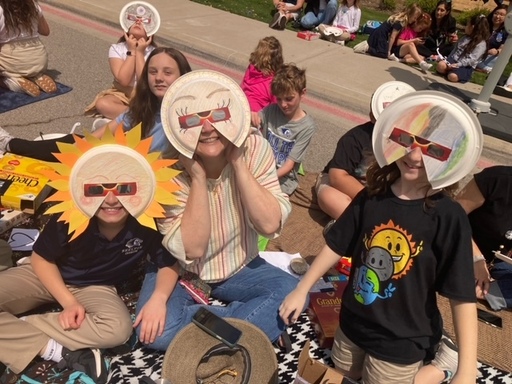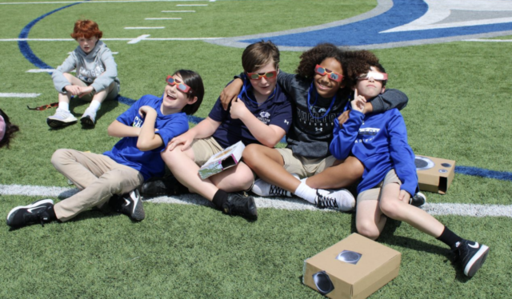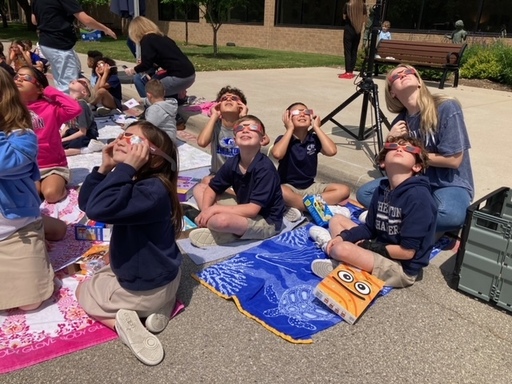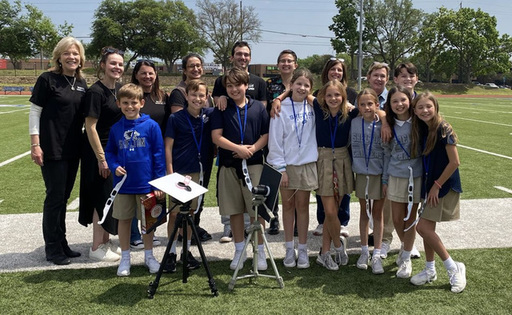Shelton Teachers, staff and representatives of NASA's Neurodiversity Network helped make the once-in-a-lifetime total solar eclipse meaningful for Shelton students on April 8.
Upper School and Middle School students viewed the eclipse on the football field, and Lower School students viewed the eclipse outside the Lower School entrance. Students and staff shouted, "Five, four, three, two, one!" as the total eclipse became visible. Upper School and Middle School students started the day by attending a lecture by Ellen Torres Thompson, the Planetarium Lead Educator at The Lawrence Hall of Science in Berkeley, California, and Spyros Kasapis, a postdoctoral fellow at the NASA Ames Research Center. Thompson spoke about the science behind the eclipse and Kasapis spoke about "NASA Heliophysics' Big Year." Shelton Physics teacher Dr. Samantha Cason and Shelton Upper School Earth and Space Science teacher Meredith Moody presented eclipse questions from Shelton students, which were answered by Thompson and Kasapis. Students also viewed a video, "Shelton Eclipsing Expectations."
In preparation for the eclipse, students benefited from curriculum from NASA's Neurodiversity Network.
- Lower School students studied what causes an eclipse, how something small can cover up something larger, eclipse safety and how to make pinhole eclipse viewers.
- Middle School students learned eclipse safety, used 3D and 2D models to describe what happened to cause an eclipse and made pinhole viewers. In addition, some classes made simple sundials and looked at the magnetic properties of the sun and Earth.
- In twelfth-grade Earth & Space Science, twelfth-grade Physics II and eleventh-grade Physics, students learned how the Earth, moon and sun interact and how those interactions can cause a solar eclipse. The concept of a solar eclipse was also reinforced with videos, an app on the cell phone that follows the eclipse and activities supplied by NASA.
Visitors from NASA Neurodiversity Network spoke to Middle School and Upper School students and visited Shelton science classes for eclipse activities on Monday.
- Spyros Kasapis completed his Aerospace Engineering Bachelor’s and Master’s degrees at Worcester Polytechnic Institute, where he focused on controls and autonomous aircraft path planning. He moved to the University of Michigan-Ann Arbor for his second Master’s degree in Naval Architecture and Marine Engineering. His Ph.D. was focused on Machine Learning applications in visual recognition. He has worked as an intern at the NASA Goddard Space Flight Center, where he helped by characterizing the Van Allen radiation belt using the SDO satellite data. Additionally, he was a member of the NASA JPL 2022 Planetary Science Summer School cohort, where he worked on the Gelatto asteroid sample return mission proposal. He is currently a Postdoctoral Fellow at the NASA Ames Research Center. His research interests include the use of Machine Learning for Detection of Solar Active Region Emergence and SEP Prediction.
-
Ellen Torres Thompson is the Planetarium Lead Educator at The Lawrence Hall of Science, a children’s museum in Berkeley, California. She develops and presents live, interactive astronomy programs for K-12 students and families. She graduated in 2021 with majors in Astrophysics and South and Southeast Asian Studies from UC Berkeley.
- Ariana Riccio is collaborating on NASA’s Neurodiversity Network, which is working to create pathways to NASA participation and STEM careers for neurodiverse learners. Riccio holds a Ph.D. in Developmental Psychology from the Graduate Center of The City University of New York and a BS in Biology and Community Health from Tufts University.




